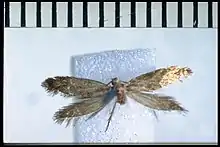Mnesarchaea fallax
Mnesarchaea fallax is a species of primitive moth in the family Mnesarchaeidae. It is endemic to New Zealand. This species is found in the Taranaki, Taupo, Nelson and Buller regions. It lives in a variety of habitats such as beech forest clearings, native podocarp forest, red tussock grasslands as well as in flax wetlands and at higher altitudes of up to 1300m. Much of the life history of this species is unknown and as at 2021 the host plants of this species have yet to be confirmed. The adult moths are on the wing from October to December. This species is classified as "Not Threatened" by the Department of Conservation.
| Mnesarchaea fallax | |
|---|---|
 | |
| Scientific classification | |
| Domain: | Eukaryota |
| Kingdom: | Animalia |
| Phylum: | Arthropoda |
| Class: | Insecta |
| Order: | Lepidoptera |
| Family: | Mnesarchaeidae |
| Genus: | Mnesarchaea |
| Species: | M. fallax |
| Binomial name | |
| Mnesarchaea fallax | |
Taxonomy
_117.jpg.webp)
This species was described by Alfred Philpott in 1927 using specimens collected at Mount Arthur tableland at 1400m in December.[2][3] George Hudson discussed the species in 1928 in his book The Butterflies and Moths of New Zealand.[4] The holotype specimen is held at the New Zealand Arthropod Collection.[5]
Description
Philpott described the species as follows:
♂ 10 mm. Head, palpi and antennae bronzy-brown. Thorax and abdomen purplish-brown. Legs greyish-fuscous. Forewings lanceolate, costa moderately arched; bronzy-brown; a white triangular spot with a few white scales above it on tornus; a few white scales beneath costa at 4⁄5 and along termen: fringes bronzy-brown. white on tornus. Hindwings fuscous with purplish-violet sheen apically: fringes greyish-fuscous.[3]
This species is very similar in appearance to M. fusca but differs by being slightly larger in size and narrower of wing.[4] It is very similar in appearance to a caddisfly.[6] M. fallax can be distinguished from moths with a similar appearance as it has small white markings on its forewings.[6]
Distribution
This species is endemic to New Zealand.[7][8] It is found in the Taranaki, Taupo, Nelson and Buller regions.[6] Along with its type locality, this species has been collected at Ruapehu & Mount Taranaki as well as from Nelson to Lewis Pass.[9][10]
Habitat
This species has been found in a variety of habitats such as beech forest clearings, native podocarp forest, red tussock grasslands as well as in flax wetlands and at higher altitudes of up to 1300m.[6]
Biology and behaviour
This species is on the wing from October to December.[6] This flight season does not appear to overlap with its close relations M. fusca or M. hudsoni.[6] It is a day flying moth that is not attracted to light.[9] This species is often found near water.[6]
Life history and host species
Much of the life history of this species is unknown.[6] It has been speculated that the larval host plants may be lichen but larvae purported to be M. fallax have been collected from periphyton.[6]
Conservation status
This species has been classified as "Not Threatened" under the New Zealand Threat Classification System.[1]
References
- Hoare, R.J.B.; Dugdale, J.S.; Edwards, E.D.; Gibbs, G.W.; Patrick, B.H.; Hitchmough, R.A.; Rolfe, J.R. (2017). "Conservation status of New Zealand butterflies and moths (Lepidoptera), 2015" (PDF). New Zealand Threat Classification Series. 20: 9.
- "Mnesarchaea fallax Philpott, 1927". www.nzor.org.nz. Landcare Research New Zealand Ltd. Retrieved 2018-05-29.
- Philpott, A. (1927). "N.Z. Lepidoptera: notes and descriptions". Transactions and Proceedings of the New Zealand Institute. 57: 703–709.
- Hudson, G. V. (1928). The Butterflies and Moths of New Zealand. Wellington: Ferguson & Osborn Ltd. p. 367.
- Dugdale, J. S. (1988). "Lepidoptera-annotated catalogue, and keys to family-group taxa" (PDF). Fauna of New Zealand. 14: 1–264 – via Landcare Research New Zealand Ltd.
- George W. Gibbs; Niels Peder Kristensen (28 May 2019). Mnesarchaeidae (Insecta: Lepidoptera: Hepialoidea) (PDF). pp. 40–41. doi:10.7931/J2/FNZ.78. ISBN 978-0-947525-60-6. ISSN 0111-5383. Wikidata Q104802925. Archived from the original (PDF) on 19 February 2021.
{{cite book}}:|journal=ignored (help) - Gordon, Dennis P., ed. (2010). New Zealand Inventory of Biodiversity. Volume two. Kingdom Animalia: Chaetognatha, Ecdysozoa, Ichnofossils. Vol. 2. Christchurch, N.Z.: Canterbury University Press. p. 461. ISBN 9781877257933. OCLC 973607714.
- "Mnesarchaea fallax Philpott, 1927". nztcs.org.nz. 2021. Retrieved 2021-08-24.
- "NZTCS - Lepidoptera spreadsheet". www.doc.govt.nz. 2013. Retrieved 29 May 2018.
- Gibbs, G.W. (October 1989). "Local or global? Biogeography of some primitive Lepidoptera in New Zealand". New Zealand Journal of Zoology. 16 (4): 689–698. doi:10.1080/03014223.1989.10422927.
